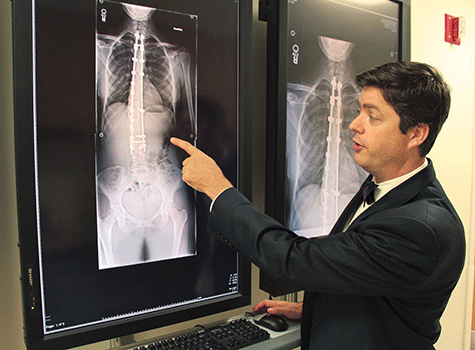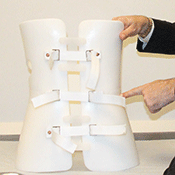
For years, adolescents instructed to wear back braces to correct scoliosis have protested having to wear the rigid plastic devices. Considering the lack of evidence in support of bracing, some may have felt they were justified in their complaints. While bracing has been recommended for decades to treat curvature of the spine, studies of its effectiveness have produced conflicting results.
But now, new results from a multicenter clinical trial provide the strongest evidence yet that back braces work in a significant percentage of cases. Further, the more hours per day they’re worn, the more effective they are.
“This is a very important landmark study in orthopedics that will allow us to guide and change treatment paradigms and care,” said Matthew B. Dobbs, MD, professor of orthopaedic surgery at Washington University School of Medicine in St. Louis and one of the study’s principal investigators. “Bracing is something that has been used for years and years but without any true evidence that it’s effective, so it’s been hard to convince patients that it’s the right treatment, especially because they don’t enjoy wearing braces.”
The braces were so effective at slowing the progression of scoliosis and helping patients avoid spine surgery that the clinical trial was ended early.
“We stopped the study after analyzing data that showed that bracing had a significant positive effect on decreasing the rate of progression of spinal curvature,” said Dobbs, whose research included patients at St. Louis Children’s Hospital and Shriners Hospitals for Children-St. Louis. “Now we’re armed with information to educate families and patients: If you wear this, you have a good chance of slowing down the curve so it doesn’t progress to the need for surgery.”
The study also involved researchers at the University of Iowa and the Hospital for Sick Children in Toronto and is available online in The New England Journal of Medicine.

The randomized study involved 242 patients, ages 10 to 15, at 25 sites in the United States and Canada. Each patient had a spinal curvature of 20 to 40 degrees. The researchers randomly assigned 116 of the children to observation or to wear a back brace for at least 18 hours each day. A second group of 126 patients had the option to choose between observation and bracing.
Among patients who wore braces, curvature of the spine was corrected successfully in 72 percent. This compared with a 48 percent success rate among those under observation who did not wear braces. Further, the more hours per day a patient wore a brace, the more likely that child’s treatment was a success.
Helping to measure how long the braces were worn by each participant were temperature-sensitive sensors in the braces. So valuable was the information they provided that Dobbs would like the sensors to become standard-issue in braces.
“If you can monitor patients’ compliance, a conversation can be had at doctor appointments about the value of wearing braces the prescribed length of time,” Dobbs explained. “It’s a pretty powerful and compelling conversation.”
Dobbs also hopes the findings result in schools reinstituting screenings for scoliosis, a practice largely left behind following a recommendation about a decade ago by the United States Preventive Services Task Force that questioned their value.
“This may bring screenings back and make this more of a health-care initiative,” he said. “There is a reason to catch this in kids early because we can do something to help many of them avoid painful and costly surgery later.”
Scoliosis develops in about 3 percent of children younger than 16, but only 0.3 percent to 0.5 percent have progressive curves that require treatment. Curves larger than 50 degrees indicate a high risk that the condition will worsen and eventually require surgery.
This research was supported by the National Institute of Arthritis and Musculoskeletal and Skin Diseases (NIAMS) at the National Institutes of Health (NIH) (R21AR049587 and R01AR052113), the Children’s Miracle Network, the Canadian Institutes of Health Research (FRN-81050), the Shriners Hospitals for Children (79125), the University of Rochester and the Children’s Mercy Hospitals and Clinics.
Weinstein SL, Dolan LA, Wright JG, Dobbs MB. Effects of bracing in adolescents with idiopathic scoliosis. The New England Journal of Medicine, Oct. 17, 2013.
Washington University School of Medicine’s 2,100 employed and volunteer faculty physicians also are the medical staff of Barnes-Jewish and St. Louis Children’s hospitals. The School of Medicine is one of the leading medical research, teaching and patient-care institutions in the nation, currently ranked sixth in the nation by U.S. News & World Report. Through its affiliations with Barnes-Jewish and St. Louis Children’s hospitals, the School of Medicine is linked to BJC HealthCare.